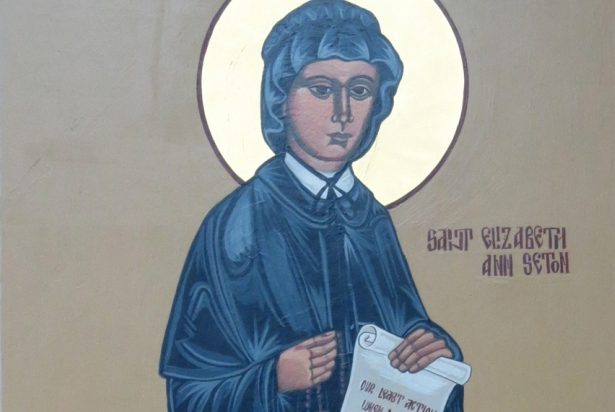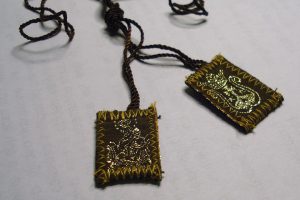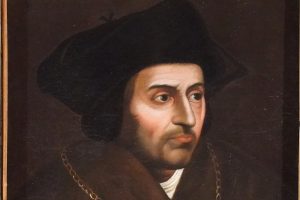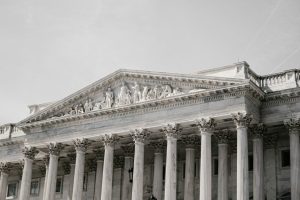Did you know that the United States has no patron saint? In part, says Kathleen Sprows Cummings, author of A Saint of Our Own: How the Quest for a Holy Hero Helped Catholics Become American, this is because U.S. Catholic understandings of the relationship between their faith and their identity as American citizens keeps changing.
Cummings points out that you can tell a lot about American Catholicism at a given point in time by who was nominated for canonization. Take, for example, the first figures nominated in the 1880s—Jesuit missionaries who were martyred in Canada. At the time, these priests were seen as the quintessential American Catholics: They came to North America with the express purpose of evangelizing to Native Americans and died for their faith.
Fifty years later, however, American Catholic understandings of citizenship and holiness had changed. Next it was women like Elizabeth Ann Seton and Frances Cabrini who were seen as the epitome of faithful Catholic life in the United States—figures who came not to conquer the wilderness but to build schools and hospitals, care for the urban poor, and live out their faith through their works.
Cummings says you can trace the story of American history through the fight to canonize holy figures. “The real heroes of the story are the people who wanted these saints known,” she says. “Those who were devoted to them, talked about the miracles and favors they had effected in people’s lives, and agitated for them to be recognized.”
What were U.S. Catholics looking for in an “American saint”?
Poet Phyllis McGinley writes about an “American brand of holiness” when talking about saints in the 1950s and ’60s. I love this phrase: American brand. But what that means, exactly, changes over the course of the century, roughly, that U.S. Catholics were seeking a national patron saint.
In the 1880s, U.S. Catholics began agitating for a national patron saint. At the time, Rose of Lima was the patron of all the Americas, from South America to Alaska. U.S. Catholics began to say, “Well, no, we need a saint who actually lived on U.S. soil.” They argued that not having a patron of the United States left them spiritually bereft: It was part of having a national identity as American Catholics.
The first people nominated were people such as the Jesuit martyrs who died in New France in the 1640s or Philippine Duchesne, a missionary from France to Missouri in the early 19th century. In nominating these figures at a time when there was a lot of anti-Catholicism in American culture, U.S. Catholics were trying to argue that Catholics had been in the country since the very beginning: They were not recent arrivals to the United States.
The Jesuit martyrs were beatified in 1925 and canonized in 1930. Great, right? Except by the time they were canonized, even though it was actually a fairly speedy process, U.S. Catholics had become more interested in finding a saint who was actually a citizen of the United States. They were not interested in having a saint who predated the founding of the United States, and you start to see comments like, “Well, those Jesuit martyrs belong to Canada.” Which is crazy, because it’s completely anachronistic—Canada and the United States didn’t exist then.
So at that point people like Frances Cabrini start to be suggested as saints. In the 1930s, Cabrini was the quintessential American. She didn’t arrive in the United States until 1889, and she died in 1917, but she was a naturalized citizen. Even though she had become a citizen mostly for practical reasons, in the eyes of U.S. Catholics it was because Cabrini embraced America in its entirety and wanted to align herself with its destiny.
Frances Cabrini was beatified in 1938 and canonized in 1946 at record speed. But by that time another shift was happening. By 1946, the United States had emerged from World War II as a global superpower and had international influence. And people like Cardinal Spellman in New York and other U.S. cardinals started to argue that it was time for a saint born and bred in the United States.
Now someone like Elizabeth Ann Seton became “more American” than Frances Cabrini, who only spent part of her life in the United States. Seton was born in New York in 1774, and she became the epitome of the American brand of holiness during this period. As a result, in 1950 Cabrini was named the patron saint of immigrants rather than of the entire United States, and Seton was canonized in 1975.
Why did it take until 1930 for any American saints to be canonized?
Canonization is a complicated and convoluted process. U.S. Catholics were really inexperienced, and they made a lot of mistakes.
Elizabeth Ann Seton’s cause, for example, took an incredibly long time, in part because the sponsoring U.S. Catholics kept forgetting parts of the process. Today, U.S. Catholics are very influential in the world and in the church. But not that long ago, they didn’t even know any of the proper procedures.
There was also a provision in canon law that stipulated women could not sponsor a cause for canonization—they had to work through a male proxy. This wasn’t changed until 1983. And while sometimes this was fine, in Seton’s case, it was a disaster. The proxy was not chosen by her congregations, but instead by Rome, and he ended up sowing dissension between the Sisters of Charity communities around the country in the name of bringing them together to forward Seton’s cause. Everything was almost derailed entirely until Cardinal Spellman of New York intervened and was able to work around him.
Finally, the Vatican was sometimes perplexed by how U.S. Catholics talked about their causes for canonization. Rome will tell you that the canonization process is very unbiased and scientific: It’s cut and dried and does not depend on local culture. But that’s just wrong: You have to look at why people get lifted up for canonization in the first place, and that depends very much on what people value, who their heroes are, and what they think of as holy in a particular time and place. And so U.S. Catholics would send these causes for canonization that talked about a person’s holiness and virtues, but also about the things they’d done, like building schools or hospitals. They sometimes talked about Frances Cabrini, for example, like she was more of a real estate tycoon than a holy person: about the properties she owned and how well she managed them. And this led to tension with the Vatican, who would say, “What does this have to do with Cabrini being a holy person?” And that, too, could slow down Americans’ causes for canonization.
What does the canonization process tell you about American understandings of holiness?
Philippine Duchesne is a great example of how canonization can often say more about the people promoting a saint than about the life of the actual candidate. Duchesne was one of the favorite causes in the 1880s and ’90s for some of the same reasons the Jesuit martyrs were popular. She worked on the frontier; she had been a missionary to the Native Americans. She came to North America to evangelize. That was a really attractive model at that time.
But by the 1930s—she was beatified in 1940—the ideal of the frontier and evangelizing a continent had lost a lot of its resonance. It was Frances Cabrini, who worked in urban spaces with immigrants, who captured the U.S. Catholic imagination. So Duchesne’s cause fell by the wayside after 1940—her community decided that promoting her cause was just not consonant with their priorities after Vatican II.
It was actually John Paul II who canonized her: Before his 1987 visit to the United States he asked the Congregation for the Causes of Saints if there was a person close to the end of the process that he could canonize. They directed him to Duchesne.
Here is someone who started out as the United States’ equivalent to Rose of Lima, but she only became canonized because of the pope’s initiative.
Why was it so important to U.S. Catholics in the 19th and early 20th century to canonize an American saint?
For two reasons. First, U.S. Catholics wanted to be recognized by the Vatican as an important country. This was at a time when the Vatican considered the United States to be a mission territory, a designation that didn’t change until 1908. American Catholics wanted the Vatican to acknowledge that holiness flourished in the United States as it did in traditionally Catholic countries of Europe. If Ireland had Patrick and Bridget, and France had Louis and Geneviève, Americans wanted a patron saint of their own, too.
Second, U.S. Catholics thought that having an American saint would make them seem more American. I was surprised when I came across this reasoning by Cardinal Gibbons, an influential archbishop of Baltimore during this time. Saints were one of the things that made Catholics seem weird to their Protestant fellow citizens, so it puzzled me that people thought an American saint would help diminish the anti-Catholicism of the late 19th century. But as I read more, I realized that U.S. Catholics really thought of it as a chance to show what they had contributed to the nation, and they were convinced that even non-Catholic Americans would be interested in a U.S. cause for canonization. Through that, people would come to see that Catholics had been good citizens and contributed to first the continent and then the nation.
Were they right? Did canonizing Americans help Catholics become more mainstream?
Yes, they were. Secular newspapers and Protestant audiences had a large interest in canonization, and these stories were regularly reported on in the media. Usually wrongly. A lot of secular audiences didn’t understand the canonization process. The New York Times, for example, would report that the Vatican was naming John Neumann an American saint, but really his cause had just moved to a new stage in the process.
There is actually a lot of evidence that Protestants paid attention to the canonization of American saints and were learning about Catholic contributions to the United States through the canonization process.
Do U.S. Catholics care as much about canonizing Americans today?
No, they don’t. While there are many open U.S. causes for canonization today, it’s usually about positioning them as having a specific Catholic brand instead of a specifically American brand. For example, Augustus Tolton is one of several candidates who could be the first black Catholic saint: He is branded as the first ordained African American priest. When Cardinal O’Connor in New York opened Dorothy Day’s cause in the 1990s, he positioned her as a pro-life saint; he talked about her as a woman who had an abortion and regretted it. This is a shift from that century between the 1880s and 1975, when Seton was canonized. Previously, it had been more about how saints expressed a vision of the American identity.
There were a few reasons for this shift. First, Vatican II changed the relationship with the saints. Saints became not less meaningful, but less integral to Catholic religious practice. In addition, by the time Seton was beatified in 1963, there was already a Catholic president. In fact, secular news outlets compared it to John F. Kennedy’s election. In a sense, her canonization was anticlimactic: U.S. Catholics had already elected one of their own to the presidency.
Then, of course, by this point U.S. church leaders had already become incredibly influential at the Vatican. They didn’t need to prove anymore that the United States was a holy place—they had already gained recognition by the Vatican.
In other words, by the 1970s the things that separated U.S. Catholics from Rome and from their fellow citizens were far less pronounced than the things that divided Catholics from one another. U.S. Catholics were dividing over politics, over controversial issues related to gender and sexuality, over race in the church. They didn’t need saints to express their Americanness; instead they looked to them to express certain priorities within the church.
Why are American saints still important?
Today, almost 150 years after Americans started bringing forth causes for canonization, there is still no patron saint of America. Part of that is that U.S. Catholics have become more aware of the diversity of the U.S. Catholic experience: What one person could possibly represent American Catholicism? So today, if you look at the people being proposed for canonization, they’re not concentrated in the northeast like most of the already canonized U.S. saints. They’re much more ethnically diverse.
There is also great hesitation on the part of many women’s religious communities in the United States to spend the time and money it takes to formally promote a cause. It’s complicated, it’s expensive, and it requires repeated engagement with church leaders at both the diocesan and Vatican level. For a variety of reasons, a lot of American women religious are not into that right now.
I totally get that, but I do wonder if we run the risk of forgetting some of the more radical visions of Catholic holiness. Canonization may be difficult, but it is really good at getting holy figures into Catholic historical memory. A hundred years from now, will we have a parish named after St. Stanley Rother, who was just beatified? Will we remember the four church women martyred in El Salvador? Will there be a parish named after Sister Dorothy Stang? Not unless they become canonized saints.
One of my students last semester wrote about Dorothy Stang. She crafted the paper as a letter to Pope Francis, basically explaining why Stang should be a saint and how she embodied Francis’ priorities for the church. She asked him to bypass the canonization process and name Stang a saint. After the semester, she sent the paper to the Sisters of Notre Dame de Namur, Stang’s community. This summer, I found out that the sisters are sending her paper straight to Pope Francis with a letter asking that he listen.
This article also appears in the February 2019 issue of U.S. Catholic (Vol. 84, No. 2, pages 28–32).
Image: Elizabeth Ann Seton, via Wikimedia Commons















Add comment